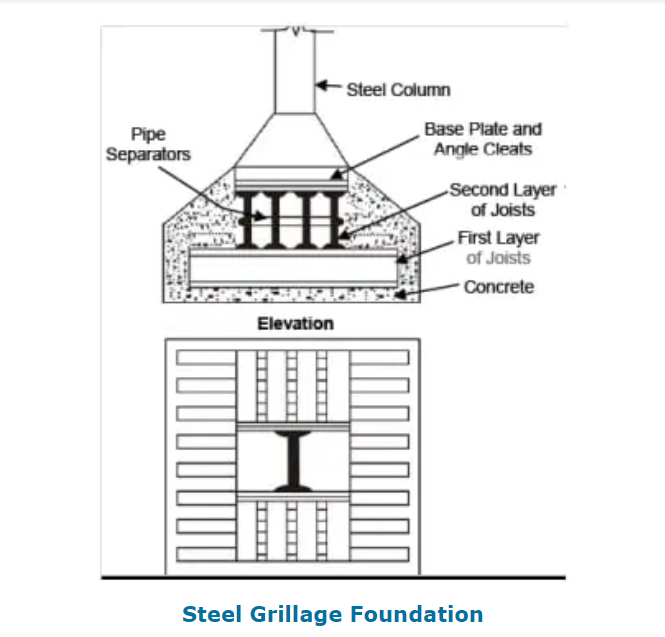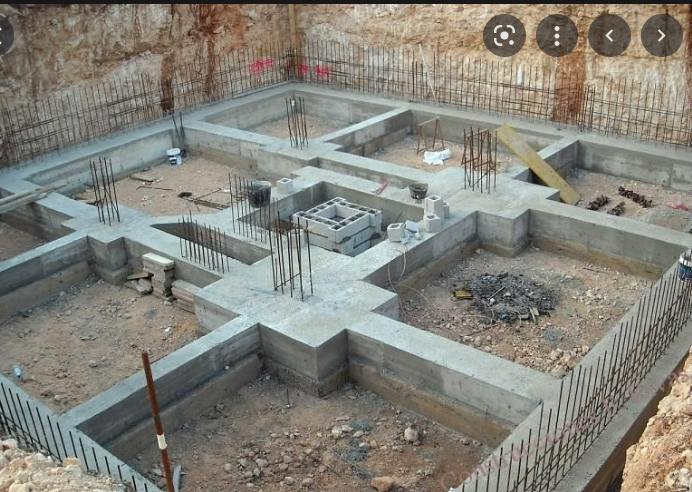Foundation is often referred to as a substructure of a building. Foundations transfer the load coming from the superstructure safely to the beneath soil. Here, types of foundations and their use cases are described.
We can classify foundations into two broader types-
- Shallow Foundation
- Deep Foundation
Shallow Foundations and Their Types
It is the one, in which the breadth-to-depth ratio is more than two. Shallow foundations are suitable where loads coming from the structure are less, or it is also preferable where firm ground strata are available at shallow depth.
The following are some types of shallow foundations.
Isolated Column Footing
This type of footing is used under a single column. The shape of the column may be circular, square, rectangular, or even complex like ‘L’ shaped or ‘T’ shaped. There are two subtypes of this type of footing.
Sloped Footing
In this type, the footing gets battered in shape.

Step Footing
This type of footing resembles the shape of steps.
Combined Footing
This type of footing is adopted when there is one column near the property line or it may be adopted when the two columns are very near each other such that separate footing is not possible.
It could also be subdivided into two types.
Rectangular Combined Footing
This type of footing is adopted where there are two columns are adjacent to each other and it is not possible to provide single-column footing. A rectangular combined footing could also be designed for more than two columns.
Trapezoidal Combined Footing
This is a type of combined footing. This type of column footing is suitable when one column carries heavier load than the another one.
Raft Foundation
This type of foundation is also known as mat foundation and these are suitable in the case of black cotton soil. Raft foundation is also used when there is a possibility of differential settlement of the foundation.
Raft foundation comprises a slab known as raft that contains beams connecting the columns of the structure.
Steel Grillage Footing
Steel grillage foundation is a type of shallow foundation used for single columns. This type of foundation is most suited for steel columns. Also, steel grillage foundation construction needs skilled labor.

Deep Foundation
As per Coulomb, a foundation is classified as Deep Foundation if its depth-to-breadth ratio exceeds two.
When firm ground strata are not available at shallow depths, the engineer may need to provide a deep foundation. The various types of deep foundations are pile foundations, caissons, under-reamed pile foundations, fenders, precast piles, etc.
Following are the types of Deep Foundations.
Pile Foundation
Pile Foundation is used where loading from the superstructure is very heavy or beneath soil has a poor bearing capacity. There are many types of pile foundations. You can get details about the pile foundation here types of pile foundation
Well Foundation
These types of foundations are adopted for bridges. This type of footing is also known as caissons.
Read Also-
Types of Pile foundations used for building construction
Types of Caissons Used for the Foundation of Bridges
Geotechnical Engineering Interview Questions
Types of Foundation for Building Construction and Their Applications
You can also pursue free courses on foundation engineering by NPTEL with the following link.
NPTEL course on foundation engineering
Most Useful Books For Geotechnical Engineering
FAQs
A floating foundation is a type of foundation which do not impart any additional load to the soil beneath the foundation. The weight of the soil excavated to place the foundation is the same or more than the weight of the building to be constructed.
Karl Von Terzaghi is known as the father of Geotechnical Engineering.
Charles Coulomb is known as the grandfather of Geotechnical Engineering.
